|
|
|
Sort Order |
|
|
|
Items / Page
|
|
|
|
|
|
|
| Srl | Item |
| 1 |
ID:
190963
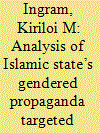

|
|
|
|
|
| Summary/Abstract |
This article analyses Islamic State’s English language propaganda targeting Western women and how that messaging changed as the group shifted from territorial control back into an insurgency. It argues that Islamic State leverages five female representations in its appeals to women in order to construct and project an alternative gender order designed to further the group’s strategic objectives. As those objectives changed, so did the nature of its appeals and the female representations its propaganda emphasised. Based on primary source analysis, it draws on fifteen issues of Dabiq which spans a period of success for the group when it controlled territories and population centres (July 2014 to July 2016) and thirteen issues of Rumiyah which was a period characterised by strategic decline back into an insurgency (September 2016 to September 2017).
|
|
|
|
|
|
|
|
|
|
|
|
|
|
|
|
| 2 |
ID:
190996
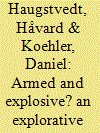

|
|
|
|
|
| Summary/Abstract |
Extremist infiltration of armed forces, and the spread of violent radicalization among service members and former soldiers, are a growing international concern. With an increased number of active duty and former soldiers involved in extremist and terrorist milieus, the public fears that national security might be compromised by potential terrorists using their training, equipment, and networks against the countries they swore to protect. This is a serious impediment to the trust in authorities for many nations. However, little empirical research exists on either the scope of the problem, or the specific risk factors that might be involved in turning military personnel toward extremism. In this paper, we utilize the “Profiles of Individual Radicalization in the United States” (PIRUS) dataset to shed light on the vulnerability and risk factors into the extremist radicalization of military personnel. Our findings indicate that far-right radicalized individuals with military backgrounds are more likely to suffer from trauma, a diminution of social standing, having difficulties in romantic relationships, and exclusion from participation in social groups or organizations, compared to far-right radicalized individuals without military backgrounds. Mental illness, grievance, and anger toward society are also more present in the far-right military group compared to the non-military group.
|
|
|
|
|
|
|
|
|
|
|
|
|
|
|
|
| 3 |
ID:
190863
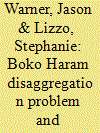

|
|
|
|
|
| Summary/Abstract |
This article introduces the “Boko Haram disaggregation problem,” or the often frequent failure by observers to disaggregate the group following its August 2016 split into two distinct factions, instead, labeling and studying all factions as “Boko Haram.” It asks: What are the origins of the “Boko Haram disaggregation problem,” and, given this phenomenon, what are the possibilities and constraints in understanding profiles of violence between the pre-2016 and post-2016 iterations of the group(s)? It argues that the “Boko Haram disaggregation problem” has origins both internal and external to the group(s), most prevalent in quantitative academic research. Highlighting the challenges of this phenomenon, it uses data from the Global Terrorism Database (GTD) from 2009 to 2018 to compare profiles of violence between various “Boko Haram” factions. In sum, it shows why beyond merely a methodological challenge, overcoming this phenomenon has real-world impacts for addressing the violence perpetrated by these groups.
|
|
|
|
|
|
|
|
|
|
|
|
|
|
|
|
| 4 |
ID:
190907
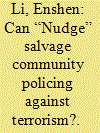

|
|
|
|
|
| Summary/Abstract |
Since the mid-2000s, the fear of “homegrown” terrorism in most developed democracies has prodded police to partner with local Muslim communities as a proactive and preventive approach to Islamic extremism. However, despite practical variations, this model of counterterrorism community policing (“CTCP”) has faced a comparable challenge—the lack of legal and moral legitimacy within counterterrorism law enforcement which erodes Muslim communities’ trust and confidence in policing. Drawing on common critiques of CTCP in the U.S., the U.K. and Australia, this article aims to proffer a behavioral-economics view to promote intended goals of CTCP. Borrowing the ideas of Nudge Theory, my discussion suggests that community engagement within CTCP could be stimulated more effectively through a subtle process of trust building whereby residents are coaxed toward cooperation through indirect encouragement, assistance and facilitation. Through a case study of CTCP in Muslim communities, it is argued that nudge entails the refrainment of the political and media narrative from conflating Islamist ideology with the prime source of domestic terrorist danger. At the grassroots level, the nudge-oriented CTCP is contingent upon community representatives taking on a more active and forefront role in CTCP with police reducing their visibility to only facilitate in the background.
|
|
|
|
|
|
|
|
|
|
|
|
|
|
|
|
| 5 |
ID:
190949


|
|
|
|
|
| Summary/Abstract |
While there has been growing concern about the use of technology by terrorist groups to organize and execute violence, there has been much less academic work on the effectiveness of governmental efforts to control the use of technology to prevent terrorist violence. Governments across the world have relied on network shutdowns to tackle violence, amongst other ends. Using data from one such country, Pakistan, this paper examines the effectiveness of disrupting cellphone networks as acounterterrorism strategy to tackle terrorist violence. This paper relies on daily data on terrorist violence in Pakistan from January 2012 to December 2017 combined with data on government-mandated cellphone shutdowns. The results show a statistically significant decline in the number of terrorist attacks on the day of cellphone shutdowns and an increase in terrorist attacks on the day after cellphone shutdown. Overall, it is argued that while cellphone shutdowns might displace terrorist violence from one day to the next, they are not an effective way to tackle terrorist violence.
|
|
|
|
|
|
|
|
|
|
|
|
|
|
|
|
| 6 |
ID:
191056
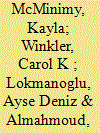

|
|
|
|
|
| Summary/Abstract |
Recognizing that militant, non-state groups utilize social media and online platforms to reach members, sympathizers, and potential recruits, state agencies and social media corporations now increasingly regulate access to accounts affiliated with such groups. Scholars examining deplatforming efforts have, to date, focused on the extent of audience loss after account restrictions and the identification of strategies for regrouping online followers on the same or different platforms over time. Left unexplored is if and how militant non-state groups adapt their official messaging strategies in response to platform restrictions despite continuing online access to them. To begin to fill that gap, this study compares ISIS’s 550 images displayed in the group’s official newsletter al-Naba six months before and after Europol’s November 2019 take-down of terrorist affiliated accounts, groups, channels, and bots on Telegram. It conducts a content analysis of images related to militaries and their outcomes, non-military activities and their outcomes, and presentational forms. The findings demonstrate that ISIS visually emphasizes its standard priming approach but shifts its agenda-setting strategy. While retaining some of its standard visual framing practices, the group also alters frames, particularly those related to images showing opposing militaries and military outcome.
|
|
|
|
|
|
|
|
|
|
|
|
|
|
|
|
| 7 |
ID:
190910


|
|
|
|
|
| Summary/Abstract |
Despite the ongoing need for researchers, practitioners, and policymakers to identify and assess the online activities of violent extremists prior to their engagement in violence offline, little is empirically known about their online behaviors generally or differences in their posting behaviors compared to non-violent extremists who share similar ideological beliefs particularly. In this study, we drew from a unique sample of violent and non-violent right-wing extremists to compare their posting behaviors within a sub-forum of the largest white supremacy web-forum. Analyses for the current study proceeded in three phases. First, we plotted the average posting trajectory for users in the sample, followed by an assessment of the rates at which they stayed active or went dormant in the sub-forum. We then used logistic regression to examine whether specific posting behaviors were characteristic of users’ violence status. The results highlight a number of noteworthy differences in the posting behaviors of violent and non-violent right-wing extremists, many of which may inform future risk factor frameworks used by law enforcement and intelligence agencies to identify credible threats online. We conclude with a discussion of the implications of this analysis, its limitations and avenues for future research.
|
|
|
|
|
|
|
|
|
|
|
|
|
|
|
|
| 8 |
ID:
191002
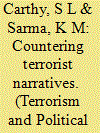

|
|
|
|
|
| Summary/Abstract |
This study presents the findings of a laboratory-based experiment testing hypothesised processes implicated in the prevention of violent radicalisation through counter-narratives. The central aims of the study were to contribute to counter-narrative theory, whilst highlighting the value of experimental methodologies that can be deployed in this area of scientific enquiry. Two counter-narrative strategies were evaluated against a dominant terrorist narrative. Considering the role of cognition in the processing of narrative-related information, participants’ (n = 150) Cognitive Reflection and Need for Cognition were measured before they were randomly assigned to a narrative that legitimized terrorist violence, one of two counter-narratives, or a control. Returning autonomy to the target by having them actively counter terrorist rhetoric themselves was found to be more effective than offering generic counter-narratives. Notwithstanding the challenges and limitations associated with measuring violent radicalization-related constructs, the findings of the experiment demonstrate the extent to which individuals vary in their susceptibility to violent, terrorist narratives, as well as attempts to counter them.
|
|
|
|
|
|
|
|
|
|
|
|
|
|
|
|
| 9 |
ID:
190897


|
|
|
|
|
| Summary/Abstract |
The potential threat posed by returning and repatriated foreign fighters and the upcoming release of homegrown violent extremists from prisons in developed democracies has raised interest in terrorist rehabilitation programs. Few studies, however, systematically examine how the public views such programs. Drawing on research on public attitudes toward prisoner reentry in criminology and social psychological theory, this study offers a series of hypotheses about support for rehabilitation programming for terrorist offenders. These hypotheses are then tested through a survey experiment on a nationally representative sample of 1,021 adult citizens in the United States. The results show that the public is less supportive of postrelease rehabilitation programming for terrorists than other criminal offenders. Support is also lower when an Islamist, rather than a white nationalist, offender is referenced. Support increases when a referenced Islamist is described as a juvenile convicted of a less serious offense. Men, younger individuals, those with some college education, and self-identified liberals are more likely to support terrorist rehabilitation programming. Finally, irrespective of treatment, respondents are most likely to cite evidence of effectiveness as the factor that would increase their support for rehabilitation programming.
|
|
|
|
|
|
|
|
|
|
|
|
|
|
|
|
| 10 |
ID:
190976
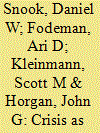

|
|
|
|
|
| Summary/Abstract |
In Western democracies, Muslim converts are overrepresented in Islamist terrorism compared to born-and-raised Muslims. Consequently, researchers have begun to consider how the process of conversion to Islam might influence participation in terrorism, yet empirical data are lacking. To explore these connections, the present study measured the conversion experiences of Muslim converts, as well as their intentions to engage in radicalism. One hundred and seventy-seven U.S. Muslim converts completed the Radicalism Intentions Scale, which measures willingness to engage in violent and illegal political behaviors to support one’s group, and the Adult Religious Conversion Experience Questionnaire, which measures the components of conversion, including crisis. Crisis is an experience of stress or difficulty that contributes to the collapse of one’s pre-conversion belief system (e.g., when an alcoholic hits “bottom”). Results indicate that the level of crisis that converts experienced was the only conversion variable associated with converts’ radicalism intentions, which suggests that crisis may be an important construct in connecting the processes of conversion to Islam and participation in Islamist terrorism.
|
|
|
|
|
|
|
|
|
|
|
|
|
|
|
|
| 11 |
ID:
191052


|
|
|
|
|
| Summary/Abstract |
The terrorist attacks in Christchurch in March 2019 and El Paso five months later emphasised the renewed relevance of ecofascism to the extreme right. This study advances an integrated definition of ecofascism with respect to the historical and contemporary extreme right. It found ecofascism to be a reactionary and revolutionary ideology that champions the regeneration of an imagined community through a return to a romanticised, ethnopluralist vision of the natural order. Ecofascists believe that their chosen community has weakened because the connection to nature has been disrupted by the forces of modernity, spanning industrialisation, urbanisation, multiculturalism, materialism, and individualism. Ecofascists therefore seek the complete rebirth of their imagined community through a return to nature, which they believe will restore the people to a state of authenticity and dominance. Because the community is based on racial constructs, the ecofascist vision of ecological harmony manifests as racial segregation based on place. This provides a platform for ecofascists to justify expelling or destroying people they deem unnatural or disruptive to the ecosystem. In settler societies, ecofascism provides the premise by which immigrants can reject and expel other immigrants, while simultaneously claiming an authentic connection with nature.
|
|
|
|
|
|
|
|
|
|
|
|
|
|
|
|
| 12 |
ID:
191014
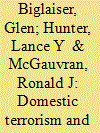

|
|
|
|
|
| Summary/Abstract |
Since the 1990s, credit rating agencies have played a prominent financial role in developing countries, rating their sovereign bonds and determining capital costs. Over much the same years, domestic terrorism has expanded, increasing market disruptions in countries. Despite the heightened costs related to rebel attacks, few studies investigate the impact of domestic terrorism on bond ratings. Using a sample of seventy-one developing countries between 1996 and 2018, we find that domestic terrorist incidents result in sovereign bond downgrades for countries that receive ratings. Further, when we disaggregate terrorist events by target type, we observe that attacks directed at the government, military and police, business, non-governmental organizations, and private citizens/property have a larger effect than other terrorist incidents. We argue that specific domestic terrorist attacks increase economic instability, leading to capital flight, and a shifting of resources from productive economic sectors to counterterrorism. The resulting economic changes weaken a country’s economy and increase debt nonpayment risk.
|
|
|
|
|
|
|
|
|
|
|
|
|
|
|
|
| 13 |
ID:
191058
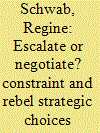

|
|
|
|
|
| Summary/Abstract |
Theories of interaction among rebel groups in civil wars, like other works in the armed conflict literature, continue to see force as foundational to the trajectory and outcome of conflict. But evidence from inter-rebel conflicts in the Syrian war, which has been one of the major civil wars of our times, shows that military force is not always the preferred tool even in situations where violence is presumably cheap: in conflicts between dominant rebel groups and weaker rivals. Rather than using force, Jabhat al-Nusra, one of the strongest groups in the Syrian conflict, frequently chose to negotiate with rivals. Existing theories of inter-rebel conflict fail to explain such variation in responses. As an explanation of this puzzle of non-force, I argue that the constraint emanating from the conflict with the main enemy determines rebels’ strategies towards rivals. To investigate this argument, the paper draws on the triangulation of original data on inter-rebel conflicts in Syria, encompassing written agreements between Jabhat al-Nusra and other rebel groups, a database of important military operations in the Syrian civil war since 2011, and interviews with civil and military participants in the insurgency. The findings have important implications not only for our understanding of inter-rebel dynamics in the Syrian conflict but also for other complex civil wars concerning the relationship between inter-rebel negotiation, cooperation, success, and war duration.
|
|
|
|
|
|
|
|
|
|
|
|
|
|
|
|
| 14 |
ID:
191034
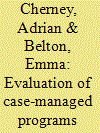

|
|
|
|
|
| Summary/Abstract |
There currently exists little evidence on the effectiveness of case-managed programs targeting radicalised individuals. This paper provides results from an evaluation of two case-managed interventions implemented by police in Australia, referred to as Intervention 1 and Intervention 2. Drawing on client case note data and interviews, the paper provides quantitative and qualitative results. It examines client change using a five-point metric and details two individual case studies. Results provide data on radicalised behaviours, intervention goals and services offered to clients. Individual client progress is explored, and the overall effectiveness of both programs examined. The results show a positive relationship between client change and different measures of engagement. Limitations of the evaluation methodology and data sources are acknowledged and addressed. Lessons are highlighted relating to the assessment of client change, program evaluation and the role of interventions in supporting disengagement.
|
|
|
|
|
|
|
|
|
|
|
|
|
|
|
|
| 15 |
ID:
191008
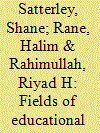

|
|
|
|
|
| Summary/Abstract |
This article contributes to our understanding of Islamist extremism by examining the relationship between early educational interests and ideas associated with Islamist-jihadist ideology. The article uses data collected through the Islam in Australia survey and specifically compares STEM (science, technology, engineering and mathematics) with HSS (humanities and social science) fields of educational interest in relation to respondents’ identification with political Islamist and militant typologies, identification with Islam as a political system, understandings of jihad and views on the caliphate as an Islamic religious obligation. The article found Muslim Australians who expressed an interest in STEM fields at high school were more likely than those interested in HSS to: (1) identify with the political Islamist and militant typology; (2) believe Islam advocates a political system; (3) believe establishing a caliphate is a religious obligation; and (4) define jihad as defensive and offensive rather than as defensive only. As discussed in the article, these findings support those of other research), which have identified an overrepresentation of STEM and an underrepresentation of HSS among Islamist-jihadists. This article adds weight to the assertion that the mindset of Islamist-jihadists, may be present prior to undertaking tertiary education and may predispose some to support extremist ideologies. This paper finds that an Islamist-jihadist ideological orientation has a relationship with the STEM fields broadly and Islamic studies specifically during adolescence.
|
|
|
|
|
|
|
|
|
|
|
|
|
|
|
|
| 16 |
ID:
191001
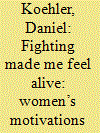

|
|
|
|
|
| Summary/Abstract |
Even though it is well documented that women have had, and continue to have, much more prominent positions and stronger participation in violent left-wing extremism and terrorism compared to other forms of political violence, the literature on their motivations to join militant left-wing milieus and groups is under-developed. Compared to female members of violent extreme right, jihadist, or ethno-separatist groups, little is known about the drivers involved in motivating women to join the violent far left. My study examines thirteen autobiographies of German and American women who were active in various forms of left-wing terrorism to shed light on their motivational themes for joining those militant groups. The analysis identified four key motivational themes across the autobiographical materials: living a completely authentic life as political warriors (consequentialism), being part of a global rebellion (internationalism), moral superiority of the cause, and responding to intolerable prison conditions caused by illegitimate governmental force or police brutality. The findings highlight the importance of understanding women’s involvement in terrorism through their own complex decisions and agency.
|
|
|
|
|
|
|
|
|
|
|
|
|
|
|
|
| 17 |
ID:
190908
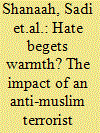

|
|
|
|
|
| Summary/Abstract |
This article examines the impact of the March 15, 2019 far-right terrorist attack against Muslims in Christchurch, New Zealand on public opinion toward Muslims. It also examines whether the impact of the attack varies for individuals across the political spectrum. We make use of data from the 2019 New Zealand Attitudes and Values Study (N = 47,951) to compare the attitudes of New Zealanders before and after the attack. Using a range of statistical techniques, including regression discontinuity analysis, we find robust evidence that the attack led to an immediate increase in warmth toward Muslims. We also show that this increase was driven by both left-wing/liberal and right-wing/conservative individuals in the immediate days after the attack. Soon after the attack, however, attitudes toward Muslims among the politically conservative population tended to revert to pre-attack levels. By contrast, political liberals maintained their heightened level of positive attitudes for a longer period. We discuss the possible theoretical reasons for these findings.
|
|
|
|
|
|
|
|
|
|
|
|
|
|
|
|
| 18 |
ID:
190972
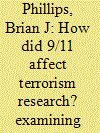

|
|
|
|
|
| Summary/Abstract |
Terrorism research increased markedly after the attacks of September 11, 2001 (9/11). How has research on this subject changed in the past twenty years? I examine data on more than 6,000 academic articles on terrorism between 1970 and 2019, and the more than 1,500 authors of multiple articles. This information comes from every article in the Web of Science database with “terrorism” or “terrorist” in the title. Several primary findings emerge. (1) The volume of terrorism research surged to record highs after 9/11, and has not decreased since. (2) Psychologists became the most numerous terrorism researchers after 9/11, displacing political scientists for about ten years. Research on health or medical aspects of terrorism jumped after 9/11. (3) The proportion of female scholars increased substantially after 9/11, outpacing the rise in academia generally. This is in part because scholars new to the field were often from disciplines with relatively high percentages of women, such as psychology. (4) Terrorism scholars were mostly based in North America or Western Europe before 9/11, but the number of countries with scholars publishing terrorism research expanded considerably after 2001. Overall, terrorism research has developed in many ways over the decades, but 9/11 led to fundamental changes.
|
|
|
|
|
|
|
|
|
|
|
|
|
|
|
|
| 19 |
ID:
190934
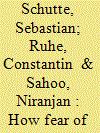

|
|
|
|
|
| Summary/Abstract |
Earlier research on ethnic and religious conflict has identified fear as an important motivation. While theoretically sound, this expectation has never been tested at larger scales in ongoing episodes of political violence. Instead, conceptual progress has been made in lab experiments. Combining insights from observational research and stylized experiments, we predict that fear for personal safety due to witnessed violence causes prejudice against out-groups, enhanced internal cohesion, and support for extremist actors. To test these predictions, we conducted surveys in the Indian State of Uttar Pradesh with identical respondents in three waves starting in January 2017. The surveys continued during the tense Legislative Assembly elections in the Spring. The results largely corroborate the theoretical expectations and present a hard in-vivo test of long-standing conjectures.
|
|
|
|
|
|
|
|
|
|
|
|
|
|
|
|
| 20 |
ID:
190911


|
|
|
|
|
| Summary/Abstract |
During the 1970s, Turkey’s radical nationalist youth were ideologically and culturally shaped by their involvement in the idealist (ülkücü) movement. The idealists also played a significant role on the streets in fomenting the mass political violence that characterized Turkey at this time. Based on the social movements literature, this paper analyzes why and how far-right movements used political violence, departing from the case of the ülkücü movement in Turkey. In doing so, the paper employs Protest Event Analysis with an original dataset of 5,361 protest events for 1971–1985. The findings suggest that far-right violence was facilitated by discursive and political opportunities, namely the praise of ruling politicians and the non-critical rhetoric of and opportunities provided by the alliance structures.
|
|
|
|
|
|
|
|
|
|
|
|
|
|
|
|
|
|
|
|
|